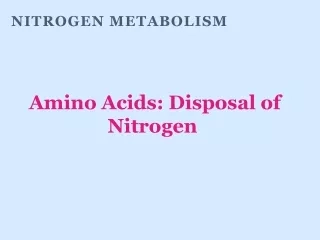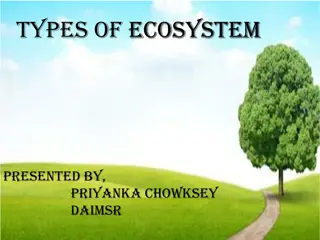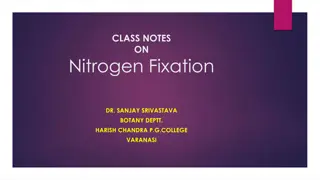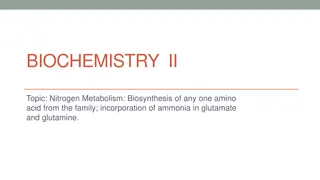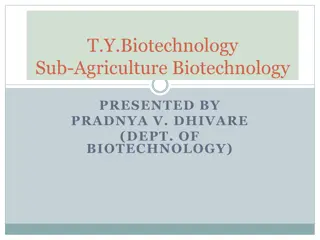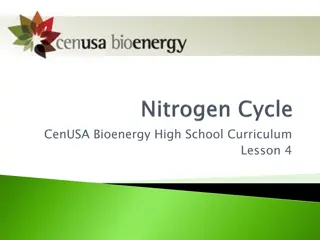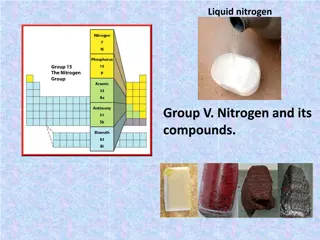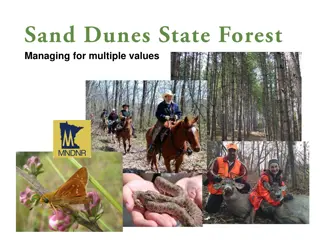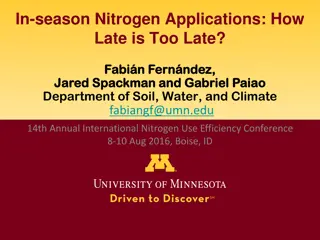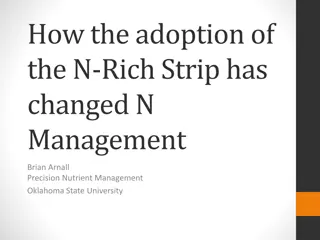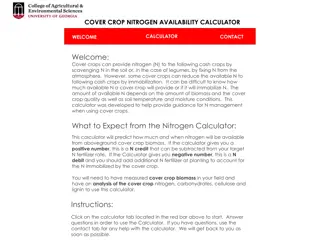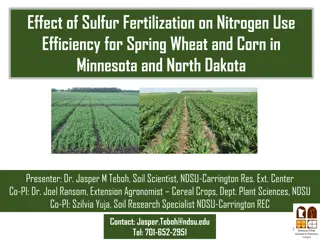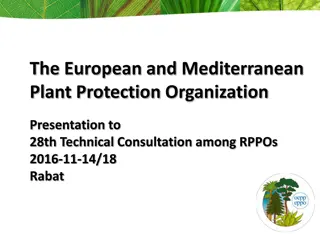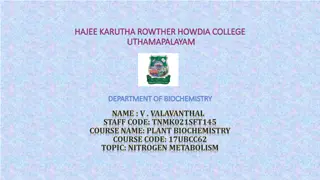Understanding Nitrogen Dynamics in a Mediterranean Savanna Ecosystem
Investigating the fate of nitrogen from fertilizer treatments and root litter turnover in a Mediterranean Savanna ecosystem. The study compares the short-term fate of 15N tracers in ecosystem stoichiometry experiments, highlighting changes in soil-plant functioning. The research addresses N turnover, ecosystem stoichiometry, and N:P imbalance effects on global carbon cycling in a typical Spanish dehesa.
- Nitrogen dynamics
- Mediterranean Savanna
- Ecosystem stoichiometry
- Soil-plant interactions
- N:P imbalance
Download Presentation

Please find below an Image/Link to download the presentation.
The content on the website is provided AS IS for your information and personal use only. It may not be sold, licensed, or shared on other websites without obtaining consent from the author. Download presentation by click this link. If you encounter any issues during the download, it is possible that the publisher has removed the file from their server.
E N D
Presentation Transcript
EGU2020-6849: Comparing from fertilizer treatments and root litter from fertilizer treatments and root litter turnover in a Mediterranean turnover in a Mediterranean Savanna Comparing the fate of N the fate of N Savanna Richard NAIR Richard NAIR / Kendalynn KendalynnMORRIS MORRIS / Gerardo MORENO / Mirco MIGLIAVACCA / Marion SCHRUMPF contact: contact: rnair@bgc-jena.mpg.de @richardnair We compare the short-term fate of 15N from fertilizers (commonly used as 15N tracers) and litter (the main source of plant-available N almost everywhere) in two ecosystem stoichiometry experiments in a Mediterranean Savanna. Habitat Habitat- - and treatment and treatment- - driven contrasts differ between methods, indicating changes in the functioning of the soil driven contrasts differ between methods, indicating changes in the functioning of the soil- -plant loop rather than the specific acquisition of mineral N loop rather than the specific acquisition of mineral N. This affects how we should interpret 15N tracer experiments, particularly where mineral N additions are used as a source. plant
Most plant nitrogen uptake is from N turnover but most N cycling experiments use mineral 15N In this display we compare two 15N tracer experiments investigating the fate of conventionally applied fertilizer 15N 15N applied as dead root biomass. We work in N+P fertilization experiment in a Mediterranean dehesa ecosystem. N deposition affects short term N availability as well as long term N pools in biomass. The shift from N to P limitation affects ecosystem functioning and ultimately their role in global C cycling. Are there differences in N partitioning from Are there differences in N partitioning from fertilizers and litter turnover? fertilizers and litter turnover? 2
MANIP experiment MANIP experiment: Altering ecosystem stoichiometry through one-off fertilization N additions shift to a N:P Imbalance, NP additions should maintain N:P stoichiometry 3
Majadas de Tietar is a typical spanish dehesa We We fertilized fertilized Majadas Majadas de de Tietar Tietar for for the the MANIP MANIP experiment experiment in in 2015 2015- -2016 2016, , this experiment is 2017-2018 Seasonally dry with a hot, biologically inactive summer and mild, wet winters Distinct microhabitats ( under under canopy open open pasture pasture ) with characteristic herbaceous communities, and soil fertility. Root-shoot ratios tend to be very large So root litter is the main internal litter source. canopy (Quercus Ilex) and Under canopy microsites are islands of fertility with higher biomass and more litter and nutrients and distinct herbaceous communities Surface soils in Open grassland microsites are wetter in winter and drier in summer due to the lack of tree root influence and hydraulic redistribution. Open grasslands also tend to be less fertile (due to less litter inputs) The growing season is approximately October to May. Litter remains from one growing season to the next, as moisture limits decomposition, but otherwise turnover of herbaceous litter is rapid.
Two experiments Two experiments We show recovery for both experiments in plants and soil in May (at the end of the growing season) and November/December (at the start of the next growing season) of the following year. The experiments are not directly paired but are comparable. MINERAL TRACER Initiated early March 15N-ammonium nitrate applied to small plots in coordination with fertilization True control not possible as cannot fertilize 15N without N Sample 5 cm topsoil for 15N recovery in plant, soil mineral pools ROOT LITTER TRACER Initiated mid December Labelled biomass applied in ingrowth cores in pre-fertilized areas Chronic 15N release from decomposition Sample 13cm ingrowth core for 15N recovery in plant, soil mineral pools 5
Fertilizer Fertilizer 15 15N N recovery in N recovery in N- -limited grassland sites limited grassland sites Morris 2019, Ecosphere 15 15N N added as ammonium added as ammonium nitrate Most common form of N tracer application Representative of deposition or fertilizer inputs Relatively logistically simple to apply in the field nitrate Higher recovery in open Higher recovery in open grassland grassland than under canopies No control recovery here No control recovery here (cannot apply 15N without adding N) Only about 25 % 15N recoverable in plant and soil system No treatment differences in No treatment differences in plot plot- -level root recovery level root recovery Open grasslands = higher recovery (Similar trends in foliage, not shown) Few consistent treatment effects* Open grasslands = more N limited, more competitive for mineral N? 6
Root litter Root litter 15 15N N: : recovery under canopies and +NP treatment recovery under canopies and +NP treatment Nair in review 15N added as root litter Logistically complex to produce litter and apply in realistic conditions More representative of the main N source in real ecosystems No significant treatment effects here Stronger root - induced induced N N limitation root recovery recovery in +NP treatment limitation via via N N leaching More total canopy microsites Generally higher than previous experiment total tracer tracer recovery in under leaching? ? higher short short- -term term recovery recovery Canopy Canopy microsites microsites more reversing reversing previous previous habitat more of of this habitat trend trend this N, N, Up to 60 % 15N recoverable in plant and soil belowground only Higher Higher canopies canopies More More 15 particularly in +NP recovery recovery in in roots roots under under Detectable +NP treatment effect 15N N Recovery Recovery per per root root mass, mass, Canopy microsites better at recycling litter N? Treatment Treatment differences differences lost (15N-litter has fully turned over?) Lower next-season recovery than mineral tracer (due to mineral pulse in frass, or discounting above-ground biomass?) lost by by December December 7 * We show root 15N recovery normalized by root mass as variable per-core mass confounds results
Nitrogen Source Matters for Predicting Ecosystem Response Nitrogen Source Matters for Predicting Ecosystem Response ROOT LITTER TRACER MINERAL TRACER More recovery in organic-rich UNDER CANOPY microsites More recovery in nutrient limited, OPEN GRASSLAND micro sites +NP leads to increased plant recovery of 15N from litter increasing uptake of decomposition products Limited treatment effects Adding balanced N and P is not affecting the partitioning of the mineral tracer in plants (mineral N is rapidly consumed by microbial pools?) Adding balanced N and P is leading to N limitations (due to N leaching?), affecting plant investment into N uptake? 8
Nitrogen Source Matters for Predicting Ecosystem Response Nitrogen Source Matters for Predicting Ecosystem Response There are very few labelled litter experiments without litterbag artefacts (see exceptions here ) and almost no comparisons against common mineral tracers in the field Fertilizer tracers may underestimate responses, and in our case reverse the observed habitat effect Induced N:P imbalance may affect internal N recycling more than short-term partitioning of mineral tracers 9
More details? Mineral tracer experiment: Morris, K. A., Nair, R. K. F., Moreno, G., Schrumpf, M., Migliavacca, M.(2019): Fate of N additions in a multiple resource limited Mediterranean oak savanna. Ecosphere 10. Labelled litter experiment: Nair et al (in review) Direct paired comparison in a different system: Nair, R. K. F., Perks, M. P., Mencuccini, M. (2017): Decomposition nitrogen is better retained than simulated deposition from mineral amendments in a temperate forest. Global Change Biology 23, 1711 1724. MANIP Project Webpage: https://www.bgc-jena.mpg.de/bgi/index.php/Research/Manip


